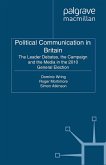The topic of this book as a result of a master's thesis has three main objectives. The first objective is to examine and analyze the causes, patterns, and structures that lead to conflicts between citizens and states. The development of peace mediation processes requires an analysis of the conflict history as well as of the conflict-triggering events in order for a sustainable peace to be realized in the post-conflict period.Therefore, this book describes the general structures and causes that lead to violent conflicts and also considers the conflict history in order to develop a theoretical model as a useful tool for improving the mediation process (the second objective).The final objective of this book is to apply the theoretical model to a specific violent conflict. The violent conflict in Kenya after the elections of 2007 is very well documented. This conflict was mediated successfully under the leadership of former Secretary of the United Nations Kofi Annan along with other members of the African Union. By refining and applying the theoretical model including the mathematical simulations, it was possible to draw attention to the enormous impact of long-term causes, the origins of which are attributable to the phase preceding the concrete conflict. Changes in citizens' trust in their political leaders harbor an enormous risk of conflict escalation, including violence. The theoretical model can also depict the significant impact of trust on citizen-state conflicts. By using simulations, it could be shown that the theoretical model is stable enough to accept different assessments in the input parameters and that these differences do not relevantly affect the main results based on those parameters in the analysis of the conflict escalation potential. When using the tool in the post-conflict period, it was demonstrated that if the long-term causes of the conflict history are not part of the political changes in the years after the peace agreements, the sustainability of peace is not maintainable and new violent conflicts can occur at any time due to unexpected and specific triggering events.








